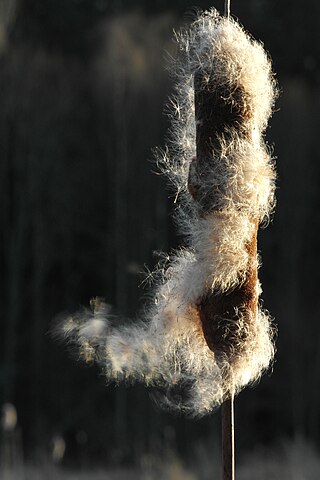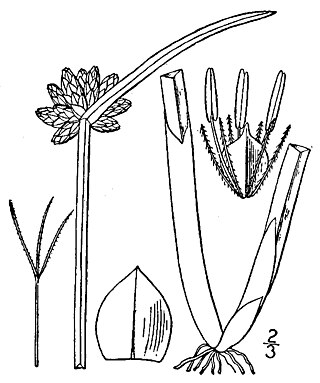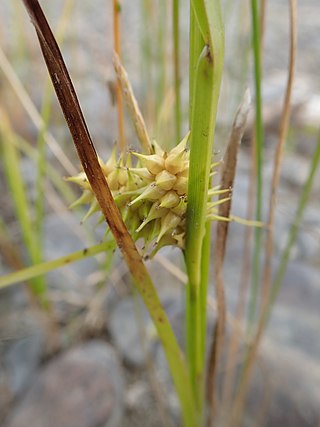
Typha is a genus of about 30 species of monocotyledonous flowering plants in the family Typhaceae. These plants have a variety of common names, in British English as bulrush or reedmace, in American English as reed, cattail, or punks, in Australia as cumbungi or bulrush, in Canada as bulrush or cattail, and in New Zealand as reed, cattail, bulrush or raupo. Other taxa of plants may be known as bulrush, including some sedges in Scirpus and related genera.

Schoenoplectus acutus, called tule, common tule, hardstem tule, tule rush, hardstem bulrush, or viscid bulrush, is a giant species of sedge in the plant family Cyperaceae, native to freshwater marshes all over North America. The common name derives from the Nāhuatl word tōllin[ˈtoːlːin], and it was first applied by the early settlers from New Spain who recognized the marsh plants in the Central Valley of California as similar to those in the marshes around Mexico City.

Scirpus is a genus of grass-like species in the sedge family Cyperaceae many with the common names club-rush, wood club-rush or bulrush. They mostly inhabit wetlands and damp locations.

Schoeneoplectus californicus is a species of sedge known by the common names California bulrush, southern bulrush and giant bulrush. It is also sometimes called "tule", but the closely related Schoenoplectus acutus is the species most often referred to by that name.

Scirpus cyperinus, commonly known as woolgrass, is an emergent wetland herb that is native to the eastern United States and eastern Canada. Other common names include cottongrass bulrush and brown woolly sedge.

Schoenoplectus pungens is a species of flowering plant in the sedge family known as common threesquare, common three-square bulrush and sharp club-rush. It is a herbaceous emergent plant that is widespread across much of North and South America as well as Europe, New Zealand and Australia.

Isolepis cernua is a species of flowering plant in the sedge family known by the common names low bulrush, slender club-rush, tufted clubrush, and fiberoptic grass. It is widespread, being native to many regions of the world, including parts of Australasia, Eurasia, Africa, and North and South America.

Scirpus congdonii is a species of flowering plant in the sedge family known by the common name Congdon's bulrush after noted Californian botanist J.W. Congdon. It is native to the mountains and plateaus of far northern California and adjacent sections of southern Oregon and western Nevada. It can be found in wetland habitat and other moist areas, such as mountain meadows and waterways. It is a perennial herb forming a loose or dense clump of erect stems growing up to half a meter tall, solitary stems sometimes occurring as well. The stems are three-angled and narrow at the middle. Sheathing leaves occur at the stem bases as well as higher up the stems. The inflorescence occurs at the end of the stem, with small additional ones growing from leaf axils. The inflorescence consists of several clusters of many spikelets wrapped at the bases in a leaflike bract.
Scirpus diffusus is a species of flowering plant in the sedge family known by the common name umbrella bulrush. It is endemic to California, where it can be found in several of the high mountain ranges from the Klamath Mountains to the Sierra Nevada. It grows in wetland habitat and other moist areas, such as mountain meadows. It is similar to Scirpus congdonii and was described from herbarium specimens once mislabeled as such. It is a perennial herb forming a clump of erect stems growing up to a meter tall, solitary stems sometimes occurring as well. The stems are three-angled and narrow at the middle. Sheathing leaves occur at the stem bases as well as higher up the stems. The inflorescence occurs at the end of the stem, with small additional ones growing from the uppermost leaf axial. The inflorescence consists of several clusters of many spikelets wrapped at the bases in a leaflike bract.

Schoenoplectus heterochaetus is a species of flowering plant in the sedge family known by the common name slender bulrush. It is native to North America, where it can be found in scattered locations in Canada and the United States.

Schoenoplectiella mucronata is a species of flowering plant in the sedge family known by the common names bog bulrush, rough-seed bulrush, and ricefield bulrush. It is native to Eurasia, Africa and Australia. It grows in moist and wet terrestrial habitat, and in shallow water. It is a perennial herb growing from a short, hard rhizome. The erect, three-angled stems grow in dense clumps and can reach a metre tall. The leaves take the form of sheaths wrapped around the base of stem, but they generally do not have blades. The inflorescence is a headlike cluster of cone-shaped spikelets accompanied by an angled, stiff bract which may look like a continuation of the stem.

Scirpus pendulus is a species of flowering plant in the sedge family known by the common names pendulous bulrush, rufous bulrush, and nodding bulrush. It is native to North America, where it can be found throughout the eastern United States and Canada, through the American midwest, some areas of the western United States, and into Mexico. It is also known as an introduced species in Australia. It grows in many types of moist and wet habitat, including disturbed areas such as ditches, and sometimes in drier areas. It is a perennial herb growing from a short, thick rhizome system. The erect, three-angled stems grow singly or in tufts and clumps, easily reaching one meter tall. Sheathing leaves occur at the stem bases as well as higher up the stems, the blades reaching up to 40 centimeters. The inflorescence is a panicle of many clusters of spikelets which hang on long, thin branches, often nodding or drooping, especially as the fruit develops.

Bolboschoenus robustus is a species of flowering plant in the sedge family. It is known by many common names: saltmarsh bulrush, alkali bulrush, sturdy bulrush, seacoast bulrush, stout bulrush, three-cornered sedge or leafy three-cornered sedge, and seaside club-rush.

Scirpus ancistrochaetus is a rare species of flowering plant in the sedge family known by the common names barbedbristle bulrush and northeastern bulrush. It is native to the northeastern United States from New Hampshire south to Virginia. It used to be found in Quebec but it is now thought to be extirpated there. It was also believed extirpated from the state of New York, but at least one population has been rediscovered in Steuben County in 2010. It is threatened by the loss and degradation of its wetland habitat. It is a federally listed endangered species.
Scirpus longii is a species of flowering plant in the sedge family known by the common name Long's bulrush. It is native to eastern North America, where it is limited to the Atlantic coastal plain.

Carex lacustris, known as lake sedge, is a tufted grass-like perennial of the sedge family (Cyperaceae), native to southern Canada and the northern United States. C. lacustris us an herbaceous surface-piercing plant that grows in water up to 50 cm (1.6 ft) deep, and grows 50–150 cm (1.6–4.9 ft) tall. It grows well in marshes and swampy woods of the boreal forest, along river and lake shores, in ditches, marshes, swamps, and other wetland habitat. It grows on muck, sedge peat, wet sand or silt, in filtered or full sunlight.

Carex cryptolepis, known as northeastern sedge, is a North American species of sedge first described by Kenneth Mackenzie in 1914.

Carex lupulina, known as hop sedge or common hop sedge, is a species of sedge native to most of eastern North America.
















